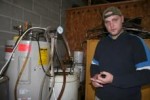Keep the oil flowing – veggie oil that is

Vegetable oil spewed from tubes connecting the vat with the reactor, spraying the chemists in the process of making fuel and leaving them dripping with oil. No, this wasn’t a scene from Dirty Jobs, but students Seth Frank and Todd Byrne making biodeisel fuel, recalled Frank laughing.
This summer former student Kristopher Setchfield and three other students set up a reactor that will hasten the process of turning vegetable oil into fuel. Throughout the summer they have been testing and re-testing to get the biodiesel fuel into a usable form.
So far, one “successful” batch has been made, said Frank.
The biodiesel fuel will be used in college lawn mowers and other diesel vehicles on campus once the club is able to start making batches regularly.
“Now that the dining hall is back up, we should have a good supply,” Dean of Administration Bill Allen said.
Sustaining the Sustainable Energy Club
To continue the biodiesel production, Setchfield and Frank are creating a Sustainable Energy Club through the help of Natalie Brassill, president of the Science Association. The first meeting will be held on Oct. 3, after Setchfield returns from his around-the-country trip on biodiesel fuel.
“We started a club to get students involved,” Frank said. “We are all in agreement to help college in any way we can to save the college a couple of bucks and to make emissions cleaner.”
The club hopes to not only be making a 40-gallon batch of biodiesel fuel every three days if all goes well, but to also team up with the Outdoor Club exchanging seeds used for oil with glycerol, which would work as a composite in the Outdoor Club’s garden, said Frank.
“It’s a huge circle,” Brassill said.
Why not make our own?
The University of New Hampshire is buying biodiesel to power campus vehicles and Middlebury College is buying B20 which is 20% biodiesel and 80% diesel.
At Castleton State College, however, these students are making their own fuel from the oil left over from Huden Dining Hall to provide for the college. Currently biodiesel costs a couple cents more than diesel fuel, unless you make your own.
While Middlebury helped raise awareness in their community by buying biodiesel, they have been set back to buying biodiesel after a student run project called Project Biobus, where students experimented using 100% biodiesel, ceased.
Although it costs more to buy biodiesel fuel, using the blended fuel will help allow Middlebury to reach its “commitment to reduce carbon dioxide emissions to 8% below 1990,” said Jack Byrne, Middlebury’s campus sustainability coordinator.
Both these schools started dabbling in biodiesel fuel because of student driven organizations that ceased when those involved graduated.
“I think it will be so immersed in the culture, especially after three or four years that the cultural expectation will be one of environmental awareness,” Castleton President David Wolk said.
Green, greener, greenest
With all the biodiesel options, it is hard to decide which one is best environmentally. Instead, organizations and groups generally pick the biodiesel option that best suits their needs.
While some would like to see all vehicles run on biodiesel produced by vegetable oil or on hydrogen, it’s really only a dream.
The country would need 140 billion gallons of biodiesel each year just to replace the fuel that is used today. To produce enough fuel from vegetable oil, the country would need to use 1.4 billion of the 2.4 billion acres of U.S. land for vegetable production for the oil, according to an article written by David Schneider.
To reduce these numbers to a mere 9.5 million acres, fuel could be harvested from algae, according to a study by Michael Briggs at University of New Hampshire. Algae would not only leave space for livestock and civilization, but the cost would be theoretically less than half what is spent on gasoline now.
Hybrid vehicles are another option Castleton is utilizing to be more environmentally friendly. Castleton recently bought two Honda Civics to add to Wolk’s personal hybrid vehicle. These hybrids are available for use to fleet drivers and have mainly been used by administrators attending meetings.
“It’s a good idea, but I don’t see society as a whole turning to them because we are so dependent on oil and they cost a lot of money,” student Jacqueline Haas said.
Hybrid vehicles run on both gas and electricity; but they get between 45-50 miles per gallon, 15 to 30 gallons more than conventional sedans, according to an article written by Professor Daniel Kammen of University of California.
The Castleton hybrids have gotten as many as 48 miles per gallon, said Linda Wetherby from Physical Plant.
“I hate it when a car’s smarter than me,” Wetherby said.
Not only do the hybrids help the environment and save on gas money, but they have other features aimed to please.
“I fit comfortably in the back seat,” Allen said, stretching out his legs. “That’s my test.”
While Frank and Brassill agree that the hybrids are good for the college, they would love even more to see diesel hybrid vehicles on campus.





